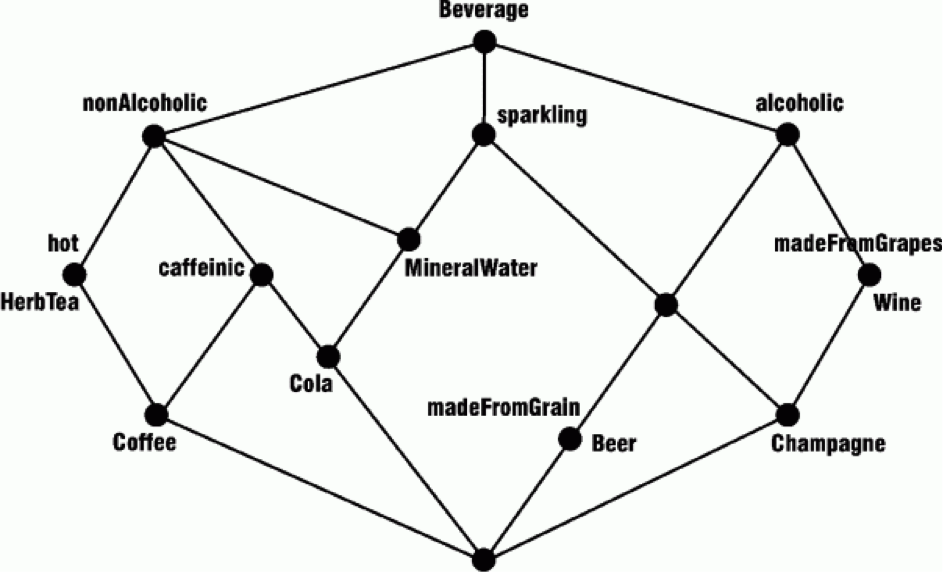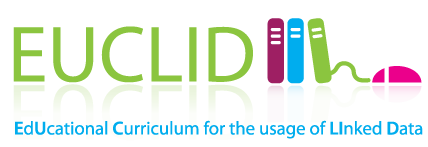Exercises
EUCLID exercises
The following exercises are also contained in the EUCLID courses.
- http://purl.org/euclid/exercise1
- http://purl.org/euclid/exercise2
- http://purl.org/euclid/exercise3
- http://purl.org/euclid/exercise4
Exercises around Linked Data and semantic technologies
The following exercises have been collected from various summer schools.
SPARQL
By Barry Norton, British Museum, United Kingdom
A triplestore was provided preloaded with music data, from MusicBrainz and the BBC's Linked Data via the Billion Triple Challenge crawl. Students were first asked to submit their FOAF profiles, including music preferences, written in Turtle. They were then introduced to SPARQL queries, including aggregate queries over the whole cohort's musical preference. Finally they were introduced to SPARQL updates, named graph-based data management, and data cleansing in refactoring the data for consistency and usability.
Social Semantics
By Matthew Row, University of Lancaster, United Kingdom
· Goal: to familiarise yourself with social semantics and using semantic data
· You will perform two tasks:
o Combining social graphs
o Detecting Web citations
· You will need:
o Laptop
o Access to the Web
o Your brains!
· You can work individually or in pairs
For the hands on I used data uploaded to the Sesame triple-store for 2 exercises (attached). I used 3 slides to explain the general lab class (attached), and then used the exercise on my web site for the students to complete: http://www.matthew-rowe.com/?q=socialsemanticslab
You can run the same exercises simply by uploading the data into your hosted triplestore and pointing them to the URL.
Ontologies (domain modeling)
By Elena Simperl, University of Southampton, United Kingdom
· Goal: to learn how to translate a natural language text into an ontological conceptualization
· You will need to perform several tasks
o Identify existing ontologies
o Identify the vocabulary
o Identify classes and instances
o Build class hierarchy
o Identify attributes and relationships
o Define further constraints
· You will need
o Pen and paper
o Access to the Internet to familiarize yourself with existing ontologies and ontology design patterns
· You can use a graphical notation of your choice, as long as you use it consistently
· You can work individually or in pairs
The current configuration of the “Red Hot Chili Peppers” are: Anthony Kiedis (vocals), Flea (bass, trumpet, keyboards, and vocals), John Frusciante (guitar), and Chad Smith (drums). The line-up has changed a few times during they years, Frusciante replaced Hillel Slovak in 1988, and when Jack Irons left the band he was briefly replaced by D.H. Peligo until the band found Chad Smith. In addition to playing guitars for Red hot Chili Peppers Frusciante also contributed to the band “The Mars Volta” as a vocalist for some time.
From September 2004, the Red Hot Chili Peppers started recording the album “Stadium Arcadium”. The album contains 28 tracks and was released on May 5 2006. It includes a track of the song “Hump de Bump”, which was composed in January 26, 2004. The critic Crian Hiatt defined the album as "the most ambitious work in his twenty-three-year career". On August 11 (2006) the band gave a live performance in Portland, Oregon (US), featuring songs from Stadium Arcadium and other albums.
Ontologies (collaboration)
By Elena Simperl, University of Southampton, United Kingdom
The aim is to reach a ‚shared conceptualization‘ of all participants at the ESWC2011 summer school on the ontology developed in the previous assigment.
· Assumption: every group is committed to their conceptualization.
· Procedure: each group selects a representative, representatives agree on an editor, and on the actual steps to be followed.
· You have 45 minutes for the exercise
Ontologies (domain modelling)
By Elena Simperl, University of Southampton, United Kingdom
· Goal: to learn how to translate a natural language text into an ontological conceptualization
· You will need to perform several tasks
o Identify existing ontologies
o Identify the vocabulary
o Identify classes and instances
o Build class hierarchy
o Identify attributes and relationships
o Define further constraints
· You will need
o Pen and paper
o Access to the Internet to familiarize yourself with existing ontologies and ontology design patterns
· You can use a graphical notation of your choice, as long as you use it consistently
· You can work individually or in pairs
Domain 1:
Describe the automotive domain using 10-20 entities, attributes and relationships
Domain 2:

Domain 3:
Barack Hussein Obama is the nominee of the Democratic Party for the office of President of the United States in the 2008 general election
Domain 4:
Peter saw Van Gogh’s sunflowers in an MOMA exhibition at the Louvre in December last year
Ontologies (relationships and cardinality constraints)
By Elena Simperl, University of Southampton, United Kingdom
· Goal: to familiarize yourself with different types of relationships, domains, ranges, and constraints.
· You will need to perform several tasks
o Identify relationship between the two entities
o Decide at which level in the class hierarchy you would define the relationship. This may lead to new classes and instances
o Define cardinality constraints
· You will need
o Pen and paper
o Access to the Internet to familiarize yourself with existing ontologies and ontology design patterns
· You can use a graphical notation of your choice, as long as you use it consistently
· You can work individually or in pairs
What is the cardinality and existence of each of the following relationships in just the direction given? State any assumptions you have to make
1. Husband to wife
2. Student to degree
3. Child to parent
4. Player to team
5. Student to course
Ontologies (using ontologies in the context of an application)
By Elena Simperl, University of Southampton, United Kingdom
· Goal: to familiarize yourself with the ontology engineering process, including requirement elicitation
· You will need to perform several tasks
o Identify domain and application-specific requirements (what will the ontology be used for? Who will see it? Who will maintain it?)
o Define competency questions
o Identify existing ontologies
o Identify the vocabulary
o Identify classes and instances
o Build class hierarchy
o Identify attributes and relationships
o Define further constraints
· You will need
o Ontology editor, e.g., Protege
o Access to the Internet to familiarize yourself with existing ontologies and ontology design patterns
· You can work individually or in pairs
Imagine an online movie recommendation portal such as IMDB or GetGlue. Develop an ontology for this domain. Implement the ontology using an editor of your choice




Add new comment